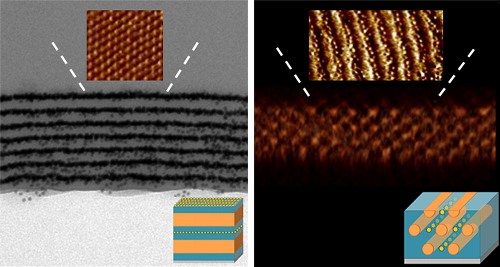A team of researchers from the University of California Berkeley and the Lawrence Berkeley National Laboratory has developed a low-cost technique to direct nanoparticles to self-assemble themselves into device-ready materials.
 Berkeley Lab researchers have developed a relatively simple and inexpensive technique for directing the self-assembly of nanoparticles into device-ready thin films with microdomains of lamellar (left) or cylindrical morphologies. (Credit: Courtesy of Ting Xu group)
Berkeley Lab researchers have developed a relatively simple and inexpensive technique for directing the self-assembly of nanoparticles into device-ready thin films with microdomains of lamellar (left) or cylindrical morphologies. (Credit: Courtesy of Ting Xu group)
The research team led by Ting Xu fabricated numerous thin film layers by blending block co-polymer supramolecules with gold nanoparticles. These thin films find use in light management, catalysis, remote sensing, energy storage, energy harvesting, memory storage, and in the up-and-coming plasmonics field.
Xu informed that this supramolecular method produces thin films by manipulating the 3-D spatial arrangement of nanoparticles with single particle accuracy over macroscopic distances. This novel technique can facilitate larger thin film fabrication and can be utilized on other material nanoparticles in addition to gold. This thin film fabrication technique is a powerful platform to explore nanoparticle structure-property correlations and enables the team to produce material structures suitable for scalable nanomanufacturing and device fabrication.
Block co-polymer supramolecules create different morphologies featuring microdomains by self-assembling themselves. These microdomains act as a suitable structural framework to enable co-self-assembling of nanoparticles thanks to their size of fewer nanometers. The nanocomposite films produced by this technique have a thickness range of 100-200 nm. Microdomains featured in these nanocomposite films are either in cylindrical or lamellar morphology.
The nanocomposite films featuring lamellar microdomains have hexagonally-packed 2-D sheets stacked parallel to the surface, while films featuring cylindrical microdomains have 1-D chains packed as irregular hexagonal lattices with orientation parallel to the surface.
Xu stated that the study results show that the novel technique can produce highly-ordered nanoparticle lattices inside the microdomains of block co-polymers and 3-D hierarchical nanoparticle assemblies with accurate structural control.
The distance between two gold nanoparticles within the 1-D chains and the 2-D sheets was only 8-10 nm, making them suitable for plasmonic applications. The gold thin films produced by the method demonstrate powerful plasmonic coupling across the inter-particle spacing within the 1-D chains and 2-D sheets. The supramolecular approach can also be utilized to develop plasmonic metamaterials.